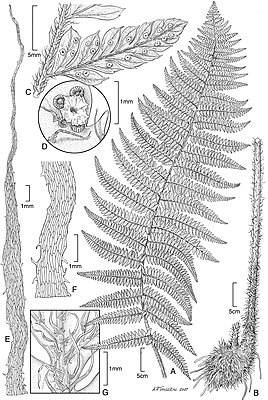Polystichum kenwoodii
| Polystichum kenwoodii | ||||||||||||
|---|---|---|---|---|---|---|---|---|---|---|---|---|

Illustration of Polystichum kenwoodii |
||||||||||||
| Systematics | ||||||||||||
|
||||||||||||
| Scientific name | ||||||||||||
| Polystichum kenwoodii | ||||||||||||
| Lorence & WLWagner |
Polystichum kenwoodii is a plant from the genus of polystichum ( polystichum ) within the family of dryopteridaceae (Dryopteridaceae). She is endemic to the southern Pacific Ocean nearby Marquesas ago Islands.
description
Polystichum kenwoodii grows as a fern . It forms an upright or semi-upright rhizome , 7 to 20 centimeters long , which is covered with scales and, together with the frond base, is between 5 and 15 centimeters thick. The uniformly brown scales on the rhizome are linear-elongated with a length of 2 to 3.5 centimeters and a width of 0.2 to 0.25 centimeters and have entire scale edges. There are also narrow, hair-like scales on the rhizome.
On each rhizome there are tufts of fronds . The fronds have 55 to 90 centimeters long and 0.5 to 0.6 centimeters thick and strong stems, which are pale brown in color. They are furrowed at the top and densely covered with reddish-brown scales at the base, which resemble those of the rhizome and are linear to linear-oblong with a length of 1 to 3 centimeters and a width of 0.15 to 0.3 centimeters . Towards the tip of the frond stalk, the density of the scales decreases, and these also become smaller and narrower, but can also be completely absent.
The triple-pinnate fronds, at least in the lower frond area, are egg-shaped to elongated-egg-shaped with a length of 50 to 83 centimeters and a width of 30 to 32 centimeters and consist of 20 to 28 pairs of leaflets. The straw-colored main axis of the fronds is sparsely to densely covered with reddish-brown, hair-like scales, which are about 0.8 centimeters long. The stiff paper-like leaflets are almost opposite to each other on the frond stalks. The lowest two to three pairs of leaflets have receded somewhat. The leaflets consist of up to 32 pairs of leaflets , which are the same size on the downward-facing side of the leaflets as on the upward-facing side. The largest leaflets are 8 to 26 centimeters long and 4.5 to 7 centimeters wide and have a linear-elongated shape and a long, pointed tip. The leaflets have a blunt and pointed tip with awning, are deeply incised and form one to two obovate lobes. In larger fronds they can also be triple-pinnate. The upper side of the leaflets is bare with the exception of a few hair-like scales at the base, while the underside is covered with whitish to light brown hair scales. The leaflet edges are serrated or notched. The branching leaf veins are difficult to see on the upper side of the leaflet, but clearly visible on the underside.
The thin, light brown Sori are short-lived and are covered by a shield-shaped indusium , which is 0.5 to 0.7 millimeters in size. The spores are dark brown in color.
Occurrence
The natural range of Polystichum kenwoodii is on the Marquesas Islands in the South Pacific . It includes the islands of Hiva Oa , Tahuata and Ua Huka .
Polystichum kenwoodii thrives at altitudes of 600 to 884 meters. The species is found in mountainous regions, in moderately damp to damp forests and in bushland, where it grows along rivers. The type often grows along with Alsophila tahitensis , Alstonia marquisensis , Boehmeria virgata , bastardianum Cheirodendron , Crossostylis biflora , Cyclophyllum barbatum , Ficus prolixa , members of the genus Freycinetia , the Lindenblättrigen Marshmallow ( Hibiscus tiliaceus ) Metrosideros collina , grantii Myrsine , Pandanus tectorius , Reynoldsia marchionensis , Weinmannia marquesana and Xyolosma suaveolens .
Systematics
It was first described as Polystichum kenwoodii in 2011 by David H. Lorence and Warren Lambert Wagner in PhytoKeys , number 4, page 22. The specific epithet kenwoodii honors the botanist Kenneth R. Wood , who collected the type material of the species.
swell
- David H. Lorence, Warren L. Wagner, Kenneth R. Wood, Alan R. Smith: New pteridophyte species and combinations from the Marquesas Islands, French Polynesia . In: PhytoKeys . No. 4 , 2011, ISSN 1314-2003 , p. 5-51 , doi : 10.3897 / phytokeys.4.1602 .
Individual evidence
- ↑ a b c d e f g David H. Lorence, Warren L. Wagner, Kenneth R. Wood, Alan R. Smith: New pteridophyte species and combinations from the Marquesas Islands, French Polynesia . In: PhytoKeys . No. 4 , 2011, ISSN 1314-2003 , p. 5-51 , doi : 10.3897 / phytokeys.4.1602 .
- ↑ Polystichum kenwoodii. In: The International Plant Names Index. www.ipni.org, accessed March 7, 2015 (English).
